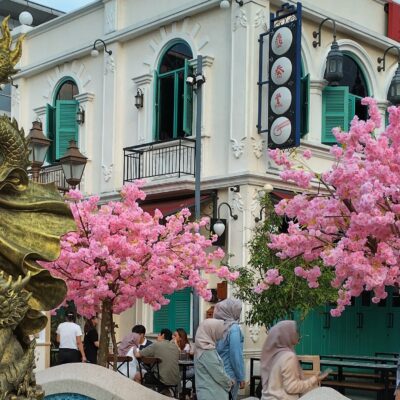
Subhan Zein’s book Language Policy in Superdiverse Indonesia provides a substantial review of the dynamics of language, policy and language shift in Indonesia. There is no shortage of scholars praising Indonesia’s language planning. However, few books have investigated its underpinnings, and arguably none have done it as thoroughly as Zein has here.
Each chapter examines aspects of the Indonesian planning ‘miracle’: the uniting of more than 600 ethnolinguistic groups through the Indonesian language. Zein casts a critical eye on this miracle—highlighting the diversity of Indonesia, and how this diversity has been understated, under-supported and politicised. He uses the lessons of the past, and observations about the present, to forge practical suggestions for Indonesia’s linguistic future.
In Chapter 1, language policy in the Indonesian situation is contexualised. Zein introduces the concept of superdiversity—increased diversity of contact in contemporary society, and consequently the need for multidimensional perspectives on diversity. Zein argues Indonesian superdiversity entails people engaging in language use at different scales of interaction (interpersonal, schooling, government). Consequently, he argues, more attention should be paid to diversity in the context of language policy and planning in the archipelago.
In Chapter 2, Zein coins a new concept—superglossia. Indonesia has sometimes been analysed as a diglossic situation, where people use a highly codified and imposed H or ‘High’ variety (Standard Indonesian) in impersonal and formal domains, but use an L or ‘Low’ variety (local, ethnic language or local Indonesian variety) in informal domains.
The author joins other scholars in arguing that diglossia understates the complexities of Indonesia. Standard Indonesian isn’t the only lingua franca used across the Indonesian archipelago. For instance, those in some regional hubs prefer Malayic Regional Lingua Franca (e.g. Ambon Malay, Kupang Malay) or non-Malayic Regional Lingua Franca (e.g. Biak, Bugis).
Chapter 3 turns to status planning, which Zein argues entails ‘deliberate efforts directed towards securing the allocation of roles and functions of languages and literacies over a community or national territory’. Zein provides a well-needed update on status planning in decentralised Indonesia. He shows how regional languages are finding more recognition and support from the government, but also argues that the Badan Bahasa, Indonesia’s national language development body, should take on a greater leadership role in relation to marginalised languages like Indonesian sign languages and Chinese heritage languages.
In Chapter 4, Zein addresses corpus planning, which entails the documentation of languages, the cultivation and codification of languages, and the coinage of new words. As with Chapter 3, he reviews the Indonesian ‘miracle’, but then provides a much-needed post-New Order update. Amidst decentralisation, the story that emerges is one of unequal distribution of Badan Bahasa centres, and a need for greater support of languages other than Indonesian (LOTIs). This chapter includes an extensive listing and light review of Indonesian/international scholars who have studied Indonesian and LOTIs.
Chapter 5 and Chapter 6 outline how language planning unfolds at different scales in Indonesia. Zein addresses language revitalisation planning and how globalisation and mobility—including intra-national mobility—can lead some languages to become endangered. Zein promotes innovative solutions to revitalisation planning, including political reconciliation (for example, the 2002 Malino Accord-signed by warring parties in Maluku-specifically references the parties’ shared cultural and linguistic heritage, and that this heritage should be embedded in the school curriculum), and the importance of policies on the use of language in the home and among family. Chapter 5 includes an extensive listing of scholars who have documented endangered LOTIs.
In Chapter 6, Zein takes stock of the history of language-in-education policy (also known as acquisition planning) in Indonesia. He begins by reviewing how the Indonesian miracle unfolded at the school level. Then, addressing contemporary Indonesia, Zein shows that there is a greater role for indigenous languages (e.g. Dayak), but this is hampered by practical difficulties such as finding available and qualified teachers for these languages. Zein suggests micro-language policies that allow for flexibility at the classroom level. This chapter also includes an insightful review of foreign language teaching, from Dutch to Arabic and English, before addressing the rising popularity of East Asian languages.
Chapter 7 concludes with practical guidelines on how Indonesia can celebrate and foster its language diversity. These recommendations include paying greater attention to the relationship between Indonesia’s cities and regional areas, institutional collaborations and calls for the Badan Bahasa to play a more robust role in Indonesian language planning.
Zein’s book makes a significant and even transformational contribution to our understanding of the historical and contemporary Indonesian planning context. He also looks to the future, and his synthesis of status planning, corpus planning, revitalisation planning and acquisition planning (dealt with in each respective chapter) provides some practical steps forward.
Most laudably, Zein’s account of language planning includes many languages previously overlooked in accounts of the Indonesian situation. The discussion of Indonesian sign languages, Chinese heritage languages and the relevance of regional lingua franca make this book an inclusive and bold contribution to Indonesian language scholarship.
At times, the book buckles under its breadth. Zein provides extensive listings of prior work on Indonesian and LOTIs, but these are sometimes presented in a way that can seem more like annotated bibliography than literature review. Scholars of one field or another might find something in here that niggles them. For me, this included the handling of the terms ‘language’ and ‘dialect’, which sometimes reflected folk approaches to the terms (inequality), rather than linguistic understandings of the terms (differing ways of framing and talking about linguistic systems).
Some scholars might bristle at the introduction of the new term ‘superglossia’, having weathered diglossia, polyglossia and others. However, by the end of the book, I was convinced superglossia has substance—reflecting the complex series of ‘hubs and peripheries’, as Zein describes it, that make up the Indonesian linguistic context.
Language Policy in Superdiverse Indonesia is a significant contribution to our understanding of the subject and a powerful act of consilience—a synthesis of knowledge about language in Indonesia.
Main image: The Indonesian islands of Komodo, Rintja, Padar, and Flores in the Komodo National Park. Original from NASA. Credit: Raw Pixel/Flickr. This image has been cropped.




